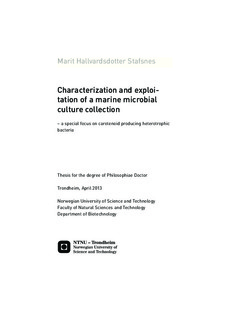| dc.contributor.author | Stafsnes, Marit Hallvardsdotter | nb_NO |
| dc.date.accessioned | 2014-12-19T13:15:12Z | |
| dc.date.available | 2014-12-19T13:15:12Z | |
| dc.date.created | 2013-05-31 | nb_NO |
| dc.date.issued | 2013 | nb_NO |
| dc.identifier | 625978 | nb_NO |
| dc.identifier.isbn | 978-82-471-4379-7 (printed ver.) | nb_NO |
| dc.identifier.isbn | 978-82-471-4380-3 (electronic ver.) | nb_NO |
| dc.identifier.uri | http://hdl.handle.net/11250/245930 | |
| dc.description.abstract | Marine microorganisms are regarded promising sources of bioactive molecules. For this reason, a marine heterotrophic bacterial collection from the sea surface microlayer had been established intending to identify molecules with potential commercial interest. To exploit this bacterial collection, rational screening procedures have to be developed. A high-throughput LC-MS protocol was established for screening of pigmented bacteria, rapidly characterizing the UV/Vis properties of the pigments. Between one and ten distinct pigments were identified in each bacterial isolate, with the majority of isolates producing three to five pigments. Carotenoids were the focus of this study, in particular carotenoids absorbing light in the upper UVA/visible light area. This type of carotenoids can be valuable as sunscreen agents, complementing the protection where conventional sunscreens offer low or no protection. In this study, several potential producer strains were identified.
Among several bright yellow colored bacterial strains from the culture collection, one formed more intensively colored colonies than the others did. The isolate, designated Otnes7 was determined to be a Micrococcus luteus strain, and LCMS analysis of extracted pigments revealed the C50 γ-cyclic sarcinaxanthin as the major accumulated carotenoid. In silico screening of the genomic sequence data of M. luteus strain NCTC2665 resulted in identification of a putative carotenoid biosynthesis gene cluster. The genes in this cluster were putatively encoding for GGPP synthase (CrtE), phytoene synthase (CrtB), phytoene desaturase (CrtI), lycopene elongase (CrtE2), C50 γ- cyclase subunit (CrtYg), C50 γ-cyclase subunit (CrtYh), and glycosyl transferase (CrtX). The complete crt gene cluster was cloned from strain Otnes7 and NCTC2665 in Escherichia coli hosts, and the sarcinaxanthin biosynthetic pathway was experimentally elucidated. Partial expression of the gene clusters were performed to reveal the single steps in the sarcinaxanthin biosynthesis. Carotenoid analysis from the resulting strains by LC-MS and NMR revealed that sarcinaxanthin is synthesized from the precursor farnesyl pyrophosphate via the intermediates lycopene, nonaflavuxanthin and flavuxanthin. Eventually 10-20 % of the sarcinaxanthin is glycosylated by CrtX.
Heterologous expression of the genes in E. coli by using the adjustable Pm promoter resulted in up to 10-fold higher sarcinaxanthin production levels compared to the levels obtained by M. luteus strains under comparable laboratory conditions.
Flavuxanthin is also an intermediate in the biosynthesis of the structurally related ε- cyclic decaprenoxanthin. In an attempt to understand the specific difference between the biosynthetic pathway of sarcinaxanthin and decaprenoxanthin, a hybrid gene cluster combining the lycopene elongase gene (crtE2) from M.luteus Otnes7 with the two genes encoding for C50 carotenoid cyclase subunits (crtYe and crtYf) in the decaprenoxanthin producing organism Corynebacterium glutamicum was constructed. Surprisingly, three different C50 carotenoids were identified in this construct; decaprenoxanthin, sarcinaxanthin and a new C50 carotenoid denominated sarprenoxanthin. These data contribute to new insight into the diverse and multiple functions of bacterial C50 carotenoid cyclases and these cyclases should therefore provide attractive targets for pathway diversification and directed genetic engineering to generate novel carotenoids.
In an effort to develop rational screening tools for identification of novel pigment producers in the marine bacterial collection, MALDI-TOF-MS was explored as a dereplication tool. MALDI-TOF-MS analysis and subsequent creation of similarity based dendrogram from nearly 400 strains from the bacterial collection showed that the bacterial collection is a diverse collection of marine heterotrophic bacteria. The pigmented bacteria showed greater diversity than the non-pigmented bacteria. Pigment extracts from a selection of the pigmented strains was analyzed with LC-DAD-MS. A dendrogram based on their pigment profiles was created. The pigment profile dendrogram was then linked to the corresponding MALDI-TOF MS dendrogram. These results show that pigment profiles can be used as taxonomic markers when the isolates produce at least three different pigments. In addition, MALDI-TOF MS can be used as dereplication tool to avoid redundant analysis without compromising the diversity of the collection when screening for novel pigmentation. | nb_NO |
| dc.language | eng | nb_NO |
| dc.publisher | Norges teknisk-naturvitenskapelige universitet, Fakultet for naturvitenskap og teknologi, Institutt for bioteknologi | nb_NO |
| dc.relation.ispartofseries | Doktoravhandlinger ved NTNU, 1503-8181; 2013:138 | nb_NO |
| dc.relation.haspart | Stafsnes, Marit H.; Josefsen, Kjell D.; Kildahl-Andersen, Geir; Valla, Svein; Ellingsen, Trond E.; Bruheim, Per. Isolation and Characterization of Marine Pigmented Bacteria from Norwegian Coastal Waters and Screening for Carotenoids with UVA-Blue Light Absorbing Properties. Journal of Microbiology. (ISSN 1225-8873). 48(1): 16-23, 2010. <a href='http://dx.doi.org/10.1007/s12275-009-0118-6'>10.1007/s12275-009-0118-6</a>. | nb_NO |
| dc.relation.haspart | Netzer, Roman; Stafsnes, Marit H.; Andreassen, Trygve; Goksoyr, Audun; Bruheim, Per; Brautaset, Trygve. Biosynthetic Pathway for gamma-Cyclic Sarcinaxanthin in Micrococcus luteus. Journal of Bacteriology. (ISSN 0021-9193). 192(21): 5688-5699, 2010. <a href='http://dx.doi.org/10.1128/JB.00724-10'>10.1128/JB.00724-10</a>. | nb_NO |
| dc.relation.haspart | Stafsnes, Marit H.; Dybwad, Marius; Brunsvik, Anders; Bruheim, Per. Large scale MALDI-TOF MS based taxa identification to identify novel pigment producers in a marine bacterial culture collection. Antonie van Leeuwenhoek. International Journal of General and Molecular Microbiology. (ISSN 0003-6072). 103(3): 603-615, 2013. <a href='http://dx.doi.org/10.1007/s10482-012-9844-6'>10.1007/s10482-012-9844-6</a>. | nb_NO |
| dc.relation.haspart | Stafsnes, Marit Hallvardsd; Bruheim, Per. Pigmented Marine Heterotrophic Bacteria. Marine Biomaterials - Characterization, Isolation and Applications: 117-147, 2013. | nb_NO |
| dc.title | Characterization and exploitation of a marine microbial culture collection: – a special focus on carotenoid producing heterotrophic bacteria | nb_NO |
| dc.type | Doctoral thesis | nb_NO |
| dc.contributor.department | Norges teknisk-naturvitenskapelige universitet, Fakultet for naturvitenskap og teknologi, Institutt for bioteknologi | nb_NO |
| dc.description.degree | PhD i bioteknologi | nb_NO |
| dc.description.degree | PhD in Biotechnology | en_GB |

